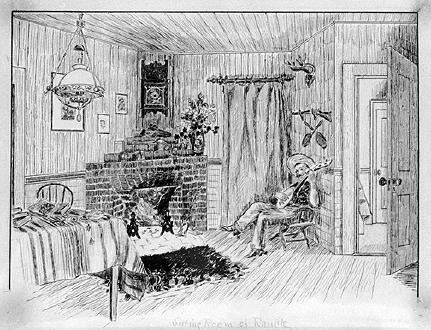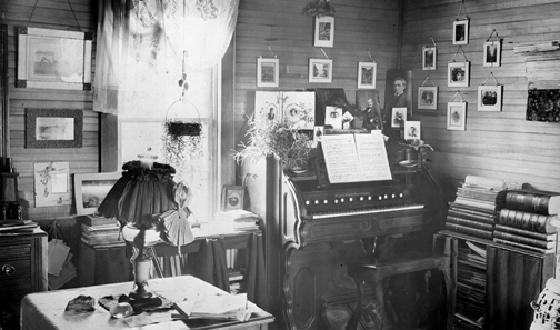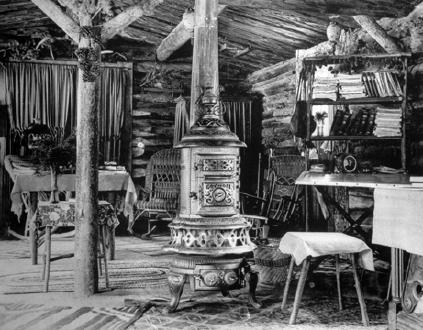Interiors
What do these photos tell you about what the houses were like on the inside?
A Ranch House Living Room
The room shown in this painting is a living room of a ranch house in Colorado. The picture was painted about 1889 by Edward Graham Hayes, who worked on the ranch. A wood-burning fireplace heated the room. The kerosene lamp hanging from the ceiling provided light in the evening.

Photo: Colorado Historical Society
More About This Topic
The interiors of houses tell us a lot about the people who lived there. This house was owned by a Colorado rancher. The badminton rackets indicate that he or other members of his family were interested in sports. The books on the table suggest that he or someone in the family liked to read. He had enough money to build a brick fireplace and to buy pictures to decorate the walls.
Their Own Words
"In the other end of the room was a fireplace in which we burned pitch logs. One of these logs would burn all evening and threw out a cheery red glow. . . . We had one kerosene lamp and some candles that Mother made out of tallow but we seldom used either as the fireplace threw out enough light for the small one-room cabin."
Source: Attie Long Thompson, "Our Home in the Petrified Forest," The Colorado Magazine, 11 (May 1934): 104.
A Living Room or Parlor
This photo shows a wood-paneled living room. The room was furnished with an organ, bookcases, and a table. The walls are covered with pictures.

Photo: Denver Public Library, Western History Collection
More About This Topic
Well-to-do people of the late 1800s bought a lot of furniture for their houses. It gave living rooms like this one a crowded look. They also decorated the furniture and covered the walls with pictures.
Their Own Words
"We are staying at the house of Amidor Sanchez, one of the old and rich men of the place. . . .The house is quite splendid in its way. The walls are covered with calico. Instead of carpets, they use cowhides, dressed with the hair on. The floor is entirely covered with them. A cushioned seat extends entirely around each room, and the walls are well covered with small paintings, most of which represent the crucifixion or some event in the life of Christ…. All the people in the place are Catholics. A cross is stuck up in the room of almost every mud house."
Source: "Nathaniel P. Hill Inspects Colorado: Letters Written in 1864," Colorado Magazine, 33 October, 1956): 267.
Living Room In Granby Ranch House
This photo was taken inside a log, ranch house near Granby, Colorado. It shows a large living room furnished with rocking chairs, tables, and a bookcase. The room was heated by a wood-burning or coal-burning stove. The photo was taken about the year 1905. This photo was taken inside a log, ranch house near Granby, Colorado. It shows a large living room furnished with rocking chairs, tables, and a bookcase. The room was heated by a wood-burning or coal-burning stove. The photo was taken about the year 1905.

Photo: Denver Public Library, Western History Collection
More About This Topic
A log house could be a very comfortable place to live. The owners of this house must have liked the “natural” look of a log house. They furnished it wicker chairs made of willow branches woven together. They decorated the walls with pinecones and pine branches.
Their Own Words
“[The house was heated] by a coal stove. They had what they call the old potbelly stoves. I can remember there in the old log house at the ranch, they had it sitting in the corner, and behind it was a bench. We’d come in with our feet cold and . . . we’d pull everything off. . . . We’d sit there and rest our feet on the bottom ring around the bottom of the stove to warm up our toes—and usually wind up burning them. But all we ever had was just the coal heat, both for the kitchen, to cook on, and for the heat.”
Source: Jennie Steele Mott quoted in Julie Jones-Eddy, ed. Homesteading Women: An Oral History of Colorado, 1890-1950 (New York: Twayne, 1992): 40-41.

